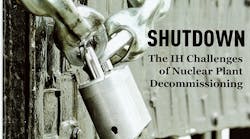Synergist Article Examines the Challenges of Decommissioning a Nuclear Power Plant
The Zion Nuclear Station in Zion, Ill., was shut down in 1998, and the decommissioning process started in 2010 under the guidance of ZionSolutions. The reactor featured two, pressurized water reactors that each produced 1,085 megawatts electrical, making the Zion Nuclear Station the largest nuclear power plant to be decommissioned, according to Greg W. Tulley, who is the manager of industrial safety and hygiene for the project.
The process is expected to be completed by 2018. Tulley, who wrote the article “When a Nuclear Power Plant Shuts Down” for the June/July issue of The Synergist, noted, “The project has yielded many valuable lessons."
He describes them on a hazard-by-hazard basis in the article. Among the hazards he lists are asbestos, hexavalent chromium, isocyanates, lead, mold, noise, PCBs, silica, thermal stress (heat and cold) and radiation.
“Decommissioning a nuclear power plant is a carefully planned and executed process,” Tulley wrote in The Synergist article. “Many of the industrial hygiene challenges that are rarely encountered in an operating nuclear power plant are daily occurrences during decommissioning.”
The digital version of the article contains photos not available in the print edition. It can be accessed by AIHA members via the American Industrial Hygiene Association Member Center.

